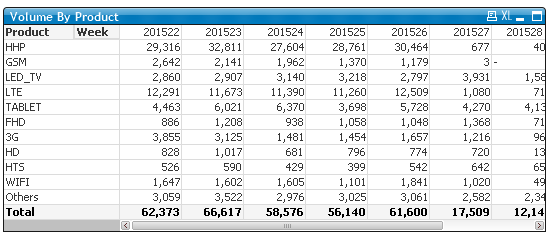Unlock a world of possibilities! Login now and discover the exclusive benefits awaiting you.
- Qlik Community
- :
- All Forums
- :
- QlikView App Dev
- :
- Re: Show Selected plus 'Others'
- Subscribe to RSS Feed
- Mark Topic as New
- Mark Topic as Read
- Float this Topic for Current User
- Bookmark
- Subscribe
- Mute
- Printer Friendly Page
- Mark as New
- Bookmark
- Subscribe
- Mute
- Subscribe to RSS Feed
- Permalink
- Report Inappropriate Content
Show Selected plus 'Others'
Hi Community,
i have a pivot table, with two dimensions and one expressions..
my dimensions are:
1) =If(Aggr(Rank(Sum(SellOut.QTY)), Product)<=10, Product, 'Others') // to show top 10 Product default
2) =Aggr(if(YearWeek > (max( TOTAL YearWeek) - 8), YearWeek), YearWeek) // to show last 8 week default.
i have one expression...
1) =if(Dimensionality()=0,SUM({<Product=>}SellOut.QTY),Sum(SellOut.QTY))
// to show the full total all the time, even if user has selected the products.
finally i see this graph.. which is correct...

now if i make selection in Product list box, let say i chose 5 Products...the chart look like below...

everything is ok, but only 'Others' row get disappear...
i want to show Selected and 'others' aswell..
how to show other all the time... all the time selected plus 'others' as a row..
i think its clear...
Many Thanks
- « Previous Replies
-
- 1
- 2
- Next Replies »
Accepted Solutions
- Mark as New
- Bookmark
- Subscribe
- Mute
- Subscribe to RSS Feed
- Permalink
- Report Inappropriate Content
Untill a proper sorting (which could be quite difficult within pivot-tables especially with calculated dimensions and a first try with dual() didn't work - but I think with some more efforts it should work, too - see for example: Perfectly Sorting Pivot Table (by A-Z. y-Value set for each dim-level)) should it work now.
- Marcus
- Mark as New
- Bookmark
- Subscribe
- Mute
- Subscribe to RSS Feed
- Permalink
- Report Inappropriate Content
You need to include a set analysis within your calculated dimension to force the displaying of Others, maybe in this way:
If(Aggr(Rank(Sum({1} SellOut.QTY)), Product)<=
if(getselectedcount(Product) < 10, if(getselectedcount(Product), 10), Product, 'Others')
- Marcus
- Mark as New
- Bookmark
- Subscribe
- Mute
- Subscribe to RSS Feed
- Permalink
- Report Inappropriate Content
Thanks Marcus..
there is an error in expression
If(Aggr(Rank(Sum({1} SellOut.QTY)), Product)<= if(getselectedcount(Product) < 10, if(getselectedcount(Product), 10), Product, 'Others')
trying to resolve error...
will let you know, if it works..
- Mark as New
- Bookmark
- Subscribe
- Mute
- Subscribe to RSS Feed
- Permalink
- Report Inappropriate Content
Maybe it's not accepting directly an expression by the selection-count query and it needs wrapped in $-sign expansion:
... $(=if(getselectedcount(Product) < 10, if(getselectedcount(Product), 10)) ...
- Marcus
- Mark as New
- Bookmark
- Subscribe
- Mute
- Subscribe to RSS Feed
- Permalink
- Report Inappropriate Content
i think problem in brackets..
see the image please,
and i could not understand the logic of text covered in red box...

- Mark as New
- Bookmark
- Subscribe
- Mute
- Subscribe to RSS Feed
- Permalink
- Report Inappropriate Content
these both are ok, but not showing 'Others'
1) =If(Aggr(Rank(Sum({1} SellOut.QTY)), Product)<= if(getselectedcount(Product) < 10, getselectedcount(Product),10), Product, 'Others')
2) =If(Aggr(Rank(Sum({1} SellOut.QTY)), Product)<= if(getselectedcount(Product) < 10, getselectedcount(Product)), Product, 'Others')
showing only selected...as before
- Mark as New
- Bookmark
- Subscribe
- Mute
- Subscribe to RSS Feed
- Permalink
- Report Inappropriate Content
I think my first suggestions was unnecessary complex and not quit suitable and think it's better to leave the calculated dimension like it was and extend the expression with set analysis of 1:
If(Aggr(Rank(Sum({1} SellOut.QTY)), Product)<=10, Product, 'Others')
= Sum({1 < Week = p(Week)>} SellOut.QTY)
- Marcus
- Mark as New
- Bookmark
- Subscribe
- Mute
- Subscribe to RSS Feed
- Permalink
- Report Inappropriate Content
i think first expression will be like
If(Aggr(Rank(Sum({1} SellOut.QTY)), Product)<=10, Sum SellOut.QTY), 'Others')
instead of
If(Aggr(Rank(Sum({1} SellOut.QTY)), Product)<=10, Product, 'Others')
but this will show 'others' in the cells, not as a row.
and where to use second expression...?
Many thanks
- Mark as New
- Bookmark
- Subscribe
- Mute
- Subscribe to RSS Feed
- Permalink
- Report Inappropriate Content
Sorry I wasn't accurate enough:
calculated dimension:
If(Aggr(Rank(Sum({1} SellOut.QTY)), Product)<=10, Product, 'Others')
expression:
= Sum({1 < Week = p(Week)>} SellOut.QTY)
- Marcus
- Mark as New
- Bookmark
- Subscribe
- Mute
- Subscribe to RSS Feed
- Permalink
- Report Inappropriate Content
if i use Sum({1<YearWeek = p(YearWeek)>} SellOut.QTY))
then i am not able to select Product, if i select Product the chart does not change because of 1.
it show all the time 10 product and 'Others' as it was.
but if i use Sum({<YearWeek = p(YearWeek)>} SellOut.QTY))
without 1 ,and if i select few Product, it shows only selected Products... no 'Others'
i think it will not work, even i tried many possibilities..but no luck
Really i appreciate your time...
Many Thanks
- « Previous Replies
-
- 1
- 2
- Next Replies »